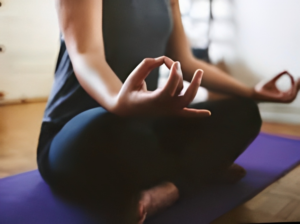Introduction
In today’s fast-moving world, we have become very busy in our work and family lives and don’t find any time for self-development. However, dedicating just five minutes of your day to meditation can bring significant benefits to your mental, emotional, and physical well-being. This article will guide you through the 5-minute meditation and help you find inner calm and peace in everyday life.

Understanding Meditation
Meditation is a practice that has been used for centuries to build a state of focused attention and awareness. It involves training the mind to achieve a mentally clear and emotionally calm state. By practicing regular meditation, you can learn to calm the mind, reduce stress, and enhance overall well-being.
The Benefits of 5-Minute Meditation
Engaging in 5-minute meditation sessions regularly can have numerous positive effects on your life. Some key benefits include:
- Reduced Stress: Taking just five minutes to meditate can help alleviate stress and promote relaxation. It allows you to step away from the constant flow of thoughts and worries, bringing a sense of calm to your mind and body.
- Improved Focus: Regular meditation enhances your ability to concentrate and stay present in the moment. It trains your mind to let go of distractions, leading to increased productivity and improved cognitive function.
- Enhanced Emotional Well-Being: By practicing 5-minute meditation, you can develop a greater sense of emotional stability and resilience. It helps you manage negative thoughts, reduce anxiety, and promote a positive outlook on life.
- Better Sleep: Engaging in a short meditation before bed can relax your body and mind, leading to improved sleep quality. It can help you unwind from the day’s activities and create a peaceful transition into a restful night.
- Increased Self-Awareness: Regular meditation cultivates self-awareness, allowing you to become more in tune with your thoughts, emotions, and bodily sensations. This will lead to better self-understanding and personal growth.
Setting Up Your Meditation Space
Creating a dedicated meditation space can significantly enhance your practice. Follow these simple steps to set up a serene and comfortable environment:
- Choose a Quiet Spot: Find a quiet area in your home where you won’t be easily disturbed. It could be a corner of a room, a cozy nook, or even a peaceful outdoor space.
- Clear the Clutter: Remove any unnecessary items from your meditation space. Clutter can be distracting and disrupt the tranquility of your practice.
- Create Ambiance: Add elements that promote relaxation, such as soft lighting, calming scents, and comfortable cushions or a meditation pillow.
- Personalize Your Space: Decorate your meditation space with objects that hold meaning for you, such as crystals, candles, or inspiring artwork.

Breathing Techniques for Relaxation
Proper breathing is fundamental to a successful meditation practice. Follow these breathing techniques to induce a state of relaxation:
- Deep Belly Breathing: Sit comfortably with your eyes closed. Inhale deeply through your nose, allowing your belly to expand. Exhale slowly through your mouth, feeling the release of tension from your body.
- Counted Breath: Inhale deeply for a count of four, hold your breath for a count of four, and exhale slowly for a count of four. Repeat this pattern several times, focusing on the rhythmic nature of your breath.
- Alternate Nostril Breathing: Gently close your right nostril with your right thumb and inhale deeply through your left nostril. Pause, then close your left nostril with your ring finger, releasing your thumb, and exhale through your right nostril. Repeat on the other side.

Thinking of the Present Moment
During your 5-minute meditation, it is important to think of the present moment. Here’s how you can practice mindfulness:
- Body Scan: Start by focusing your attention on different parts of your body, starting from the top of your head and moving down to your toes. Notice any sensations or areas of tension, and allow them to soften and relax.
- Thought Observation: Instead of getting caught up in your thoughts, observe them without judgment. Imagine your thoughts as passing clouds in the sky, coming and going without attachment.
- Anchor Point Meditation: Choose an anchor point, such as your breath, a mantra, or a visual object, to bring your attention back whenever your mind wanders. Focus on this anchor point to maintain a state of presence.
Letting Go of Distractions
Distractions are a natural part of meditation, but learning to let go of them is crucial. Here are some tips to help you stay focused:
- Acknowledge and Release: When distractions arise, acknowledge them without judgment and gently let them go. Refocus your attention on your breath or chosen anchor point.
- Use Guided Meditations: Listening to guided meditation recordings can provide structure and guidance, making it easier to navigate distractions.
- Practice Non-Attachment: Instead of getting frustrated or critical when distractions occur, practice non-attachment. Accept that distractions will arise and simply let them pass.
Embracing Mindfulness in Your Daily Life
The benefits of meditation extend beyond the time spent on the cushion. Incorporate mindfulness into your daily activities with these practices:
- Mindful Eating: Pay attention to the flavors, textures, and sensations of each bite during meals. Eat slowly and savor each moment, fully engaging your senses.
- Mindful Walking: Take a break from your busy schedule to go for a mindful walk. Notice the sensation of your feet touching the ground, the sounds around you, and the beauty of nature.
- Mindful Listening: Practice active listening by fully engaging with others during conversations. Put aside distractions and truly focus on what the person is saying, fostering deeper connections.
Maintaining Consistency in Your Practice
Consistency is key when it comes to meditation. Follow these tips to make your 5-minute meditation a regular habit:
- Set a schedule: Choose a specific time each day to dedicate to your practice. 5 minutes of meditation can be practiced in any way that fits you best. You can do it in the morning, during a lunch break, or before bed. Find a time that works best for you.
- Start Small: Begin with short 5-minute sessions and gradually increase the duration as you become more comfortable. Consistency is more important than the duration of your practice.
- Use Reminders: Set reminders on your phone or place visual cues around your living space to prompt you to meditate. This will help establish a routine and ensure you don’t forget your daily practice.
Overcoming Challenges in Meditation
Meditation can present challenges along the way. Here’s how to overcome common obstacles:
- Restlessness: If you feel restless during your meditation, try incorporating gentle movement or stretching beforehand to release excess energy.
- Wandering Mind: When your mind wanders, gently guide it back to your chosen anchor point without judgment. Accept the wandering as a natural part of the practice.
- Impatience: Meditation is a skill that develops over time. Be patient with yourself and trust that with consistent practice, you will experience the benefits.
Incorporating Guided Meditations
Guided meditations can be valuable tools for beginners and experienced practitioners alike. They provide structure, guidance, and inspiration for your meditation practice. Consider using guided meditation apps or online resources to explore different styles and themes.
Enhancing Your Meditation Experience with Music
Music can create a soothing ambiance and deepen your meditation experience. Look for calming instrumental tracks or specifically designed meditation music to accompany your practice. Experiment with different genres and find what resonates with you the most.

Conclusion
In just five minutes a day, you can start your transformative journey towards inner peace and well-being. The art of 5 minute meditation offers multiple benefits such as reducing stress and improving focus to enhancing emotional well-being and sleep quality. By integrating meditation into your daily routine and cultivating mindfulness, you can face life’s challenges easily and live happy life.
FAQs
1. How often should I practice 5-minute meditation? Ideally, aim to practice 5-minute meditation daily. Consistency is key in developing a habit and experiencing the full benefits of meditation.
2. Can I meditate for longer than 5 minutes? Absolutely! If you have the time and inclination, feel free to extend your meditation sessions beyond five minutes. However, even a short daily practice can yield significant results.
3. Is it normal to have thoughts during meditation? Yes, it’s completely normal to have thoughts arise during meditation. The key is to observe them without judgment and gently bring your focus back to your breath or chosen anchor point.
4. Can I meditate in a noisy environment? While a quiet environment can enhance your meditation experience, it’s still possible to meditate in a noisy environment. Use earplugs or incorporate the sounds around you as part of your practice, treating them as background noise.
5. Can children engage in 5-minute meditation? Yes, children can benefit from 5-minute meditation as well. It can help them develop focus, self-awareness, and emotional regulation. Simplify the instructions and make it enjoyable for them by incorporating fun elements like visualizations or guided imagery
